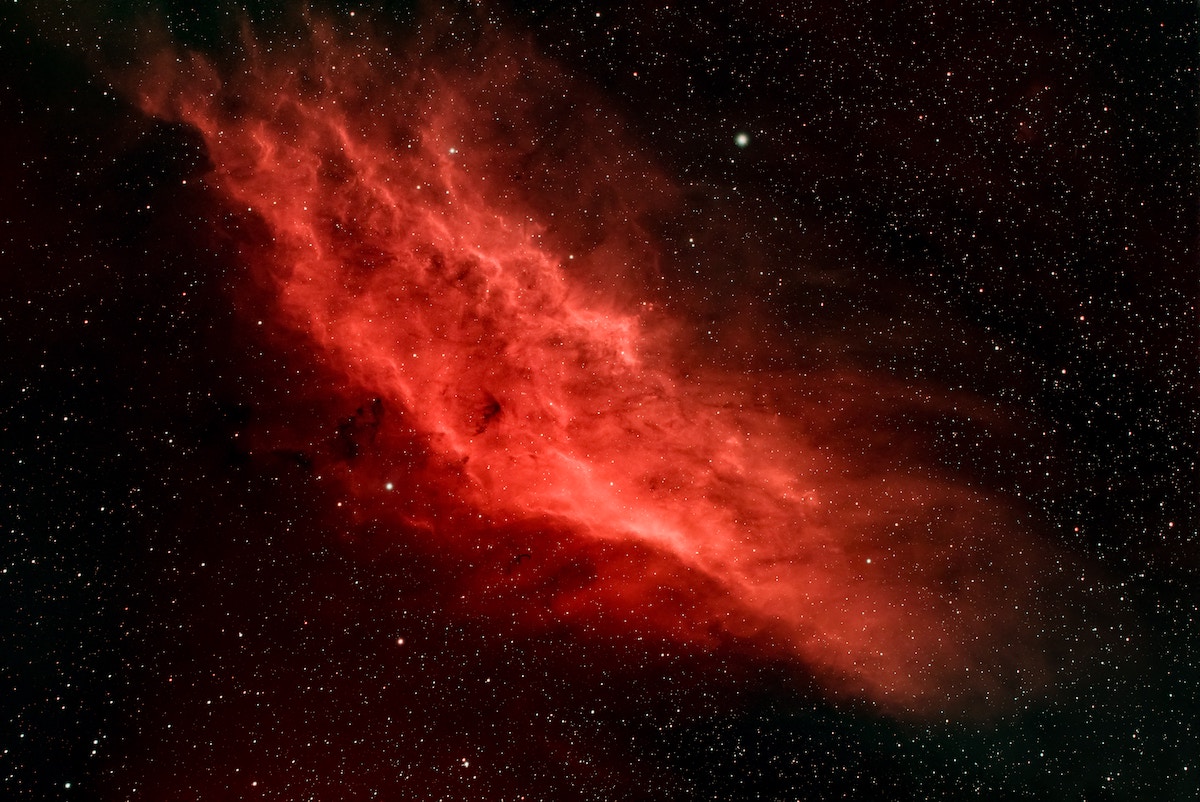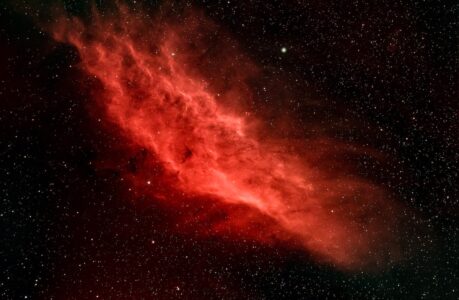The California Nebula (NGC 1499) is one of the most beautiful and famous celestial objects in the night sky. This stunning nebula is located in the constellation Perseus, approximately 1,000 light-years away from Earth, and spans over 100 light-years in diameter. It is named after its resemblance to the shape of the state of California and is a popular target for amateur and professional astronomers alike.
The California Nebula is classified as an emission nebula, which means it glows due to the ionization of gases by high-energy ultraviolet radiation from nearby stars. The nebula is predominantly made up of hydrogen gas, with smaller amounts of helium and dust. The ionization of the gas produces a reddish glow that is visible through telescopes.
The formation of the California Nebula is believed to have been triggered by the intense radiation from a nearby massive star, which caused the surrounding gas to heat up and ionize. The ionized gas then emitted radiation in the form of light, which is what we see as the colorful glow of the nebula today. This process is known as photoionization and is common in the formation of emission nebulae.
One of the unique features of the California Nebula is the dark lane that runs through its center. This lane is believed to be a region of dense dust that is blocking the light emitted by the ionized gas behind it. The dust lane gives the nebula a distinctive appearance and adds to its allure.
Another interesting aspect of the California Nebula is its location in the Milky Way galaxy. It is situated in a region of the galaxy known as the Orion Arm, which is a spiral arm that extends outwards from the galactic center. The nebula is located close to the edge of the arm, where the density of stars and gas is lower than in the central regions. This makes it an ideal target for observation, as it is not obscured by the dense clouds of gas and dust that can be found in other regions of the galaxy.
In conclusion, the California Nebula (NGC 1499) is a beautiful and fascinating object in the night sky. Its unique shape, dark dust lane, and location in the galaxy make it a favorite among astronomers and stargazers. Understanding the formation and characteristics of objects like the California Nebula can help us to better comprehend the workings of the universe and our place within it.
How to find the California Nebula
The California Nebula (NGC 1499) is a relatively large and bright emission nebula that can be spotted with a telescope or even a pair of binoculars. However, it is not visible to the naked eye due to its faintness and low surface brightness.
To find the California Nebula, you will need to locate the constellation Perseus, which is situated in the northern hemisphere of the sky. The nebula is located near the bright star Algol, which is the third brightest star in Perseus and is easily visible to the naked eye.
Once you have located Algol, use a telescope or binoculars to scan the surrounding area for a faint, hazy patch of light. The nebula appears as a dim, elongated cloud of light with a distinctive shape that resembles the state of California. It is best observed under dark, clear skies and away from light pollution.
To enhance your viewing experience, use a narrowband filter, such as an H-alpha filter, which will isolate the light emitted by the hydrogen gas in the nebula and make it easier to see. Alternatively, use a low-power eyepiece to observe the nebula at a wider field of view, which will allow you to appreciate its size and shape.
Remember to give your eyes time to adjust to the darkness and avoid looking directly at bright lights, as this can impair your night vision. With a little patience and some basic equipment, you can enjoy the beauty of the California Nebula and discover the wonders of the cosmos.
What is an Emission nebula
An emission nebula is a type of interstellar cloud of ionized gas that emits light at various wavelengths, including visible light. These nebulae are primarily composed of hydrogen gas, but can also contain other elements such as helium, oxygen, and nitrogen.
Emission nebulae are formed when the ultraviolet radiation from hot, young stars ionize the surrounding gas. This ionization process causes the gas to emit light as electrons recombine with protons to form hydrogen atoms, resulting in a distinctive glow. The color of the glow depends on the elements present in the nebula and the amount of ionization.
One of the most famous examples of an emission nebula is the Orion Nebula, which is visible to the naked eye as a hazy patch of light in the constellation Orion. Other well-known emission nebulae include the Lagoon Nebula, the Trifid Nebula, and the Eagle Nebula.
Emission nebulae are important objects for astronomers to study, as they provide valuable insights into the formation and evolution of stars and galaxies. By analyzing the light emitted by these nebulae, scientists can determine the composition and physical properties of the gas and study the processes that give rise to new stars.
Overall, emission nebulae are some of the most beautiful and awe-inspiring objects in the night sky, and their study continues to shed light on some of the deepest mysteries of the universe.
The Dark Lane
The Dark Lane is a prominent feature of the California Nebula (NGC 1499) that runs through the center of the nebula, dividing it into two distinct lobes. The Dark Lane appears as a dark and opaque streak of dust that blocks the light from the ionized gas behind it.
The Dark Lane is believed to be a region of dense interstellar dust that lies between us and the nebula. The dust absorbs and scatters light, making it appear dark and obscuring the view of the ionized gas behind it. The dust is thought to be part of a larger cloud of gas and dust in the region, which may be undergoing gravitational collapse and the formation of new stars.
The presence of the Dark Lane adds to the beauty and intrigue of the California Nebula, giving it a distinctive appearance and making it a favorite among astrophotographers. The contrast between the dark dust lane and the brightly glowing gas makes for a stunning image that highlights the intricacies and complexity of the cosmos.
Scientists also study the Dark Lane to better understand the structure and composition of interstellar dust clouds. By analyzing the way the dust absorbs and scatters light, they can determine the size, shape, and composition of the dust grains, which in turn can provide clues to the physical conditions and processes that give rise to new stars and planets.
Overall, the Dark Lane is a fascinating feature of the California Nebula that adds to its allure and serves as a reminder of the complexity and beauty of the universe.

